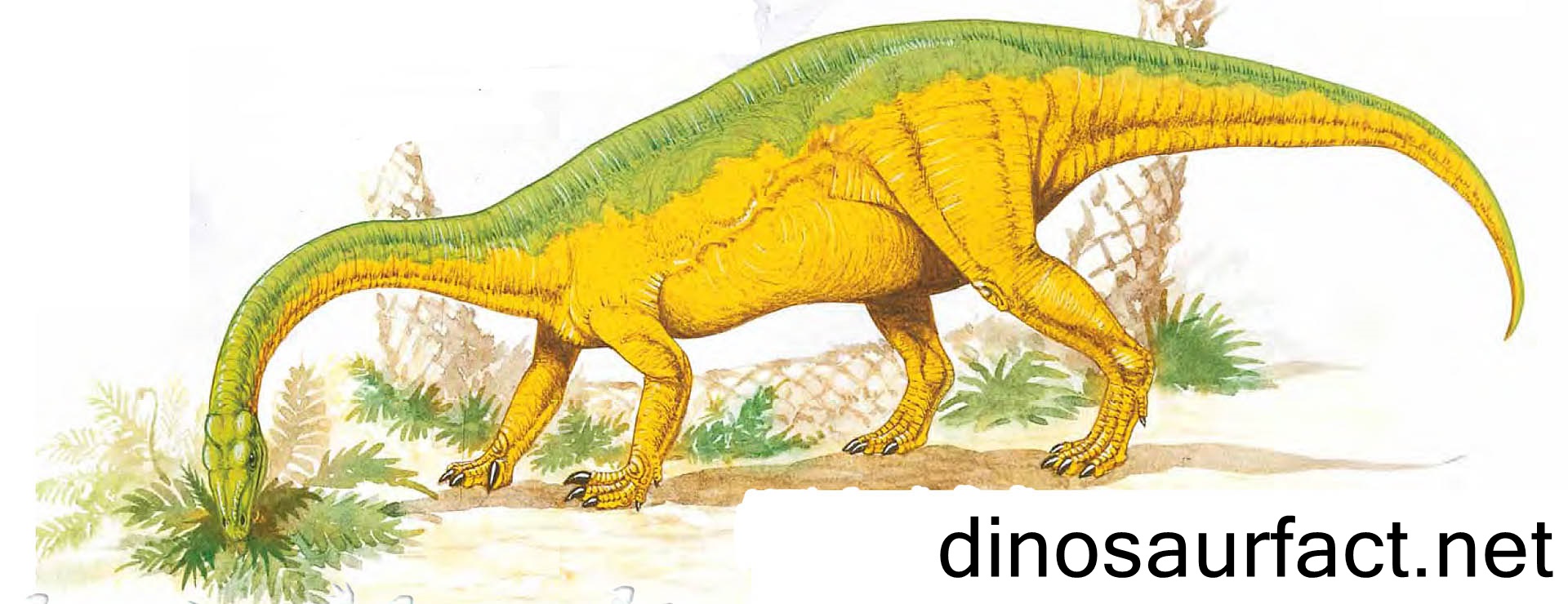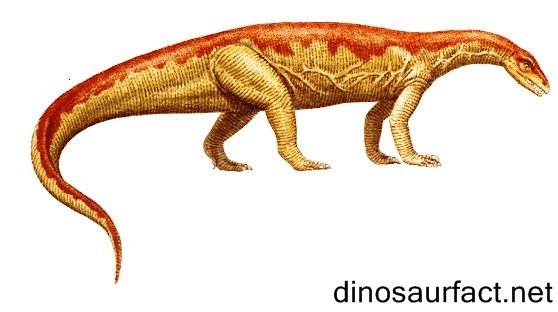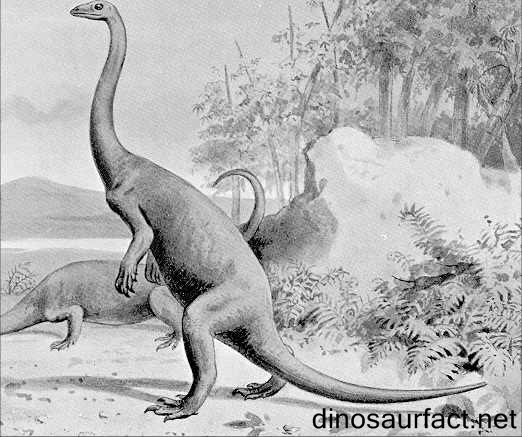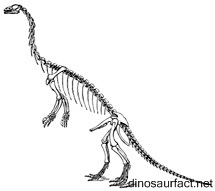 Click to visit the previous dinosaur bio
Click to visit the previous dinosaur bio
 |
|
 |
|
Kingdom: Animalia
Phylum: Chordata
Class: Sauropsida
SuperOrder: Dinosauria
SubOrder: Sauropodomorpha
Family: Anchisauridae
Genus: Anchisaurus
 |
|
 |
|
 |
|

The Anchisaurus was a dinosaur that existed on the earth in the early Jurassic period. It was a small dinosaur, growing to about 3 to 4 meters in length. Its weight most likely did not exceed 35 kilos. It is most recently grouped under primitive sauropods.
The timeline of its existence is estimated at about 199 to 189 million years ago. This lies in the Hettangian to the Pliensbachian ages of the Jurassic period. This period was abundant with prosauropods and it was initially believed that the Anchisaurus was one of them. On further investigations, it was seen that it resembled basal sauropodomorphs than prosauropods.
The fossils of the Anchisaurus were discovered in the United States. It is postulated that the dinosaur could have inhabited the whole of North America. The Anchisaurus was herbivorous and most likely hunted by the carnivorous Jurassic theropods.
The similarity that the Anchisaurus shared with basal sauropods and prosauropods has led paleontologists to believe that it could have evolved from the connecting link between these dinosaurs.
Nomenclature
The name Anchisaurus has Greek origins. The prefix ‘anchi’ translates to ‘related’ or ‘close’ in English. The suffix ‘-saurus’ is derived from the Greek word ‘sauros’ which means ‘lizard’ in English. Thus the name ‘Anchisaurus’ denotes ‘related dinosaur’.
The christening of the remains was done by O.C. Marsh. He chose this name as he believed the Anchisaurus was related to the evolved sauropods.
The binomial name Anchisaurus polyzelos translates to ‘highly sought-after’. Marsh was searching for actual dinosaur fossils in the Connecticut region for a very long and could not find them. When he finally found them in the form of the Anchisaurus, they were prized indeed.
Discovery of fossils
- The remains of the Anchisaurus were found in a pit in the Wolcott’s Quarry in Connecticut, New York. They were discovered in the Upper Portland Formation. This was almost two centuries ago in 1818.
- The remains, owing to their small size were thought to be of human origin when they were first seen. Only after noticing the peculiar jaw and the tail were they suspected to be those of a dinosaur.
- Many of the bones were discarded by the quarry workers thinking that they were of no consequence.
- However, another incomplete skeleton was discovered elsewhere in Connecticut which was well preserved. Thus, based on this finding, the genus Anchisaurus came into existence.
- A separate set of remains were also discovered by William Smith in Springfield.
Classification
- They ascribed the name Megadactylus by scientist Edward Hitchcock.
- But this name was already utilized and hence it was changed to Amphisaurus.
- In 1885, it was realized that the name Amphisaurus was taken as well and so it was replaced with Anchisaurus.
- The genus Ammosaurus is also considered the same as the Anchisaurus polyzelus.
Current location of fossils
The remains found at Springfield are preserved at Amherst College Museum of Natural History.
The other two Connecticut samples are presently located in the Peabody Museum of Natural History.
The Upper Portland Formation
- The Upper Portland Formation is a part of the Newark Super-group. It is a geological rock formation consisting of sedimentary rocks.
- This formation comprises of silt stone, sandstones and conglomerate. They look reddish to brown in color.
- The depth of the Newark Super Group can be as much as 5000 to 6000 meters.
- The fossils found in the Upper Portland Formation are from the late Triassic to the early Jurassic periods of the Mesozoic era.
Edward Hitchcock and O. C. Marsh
- Edward Hitchcock was an American scientist and geologist. He had performed note-worthy surveys in the east coast region of the United States. He was amongst the first scientists to publish reports on vertebrate fossil tracks.
- Hitchcock served as the third President of the Amherst College. He also instructed the natural theology course in the college.
- His son was also a geologist.
- He is well known for his book Elementary Geology and the paleontology chart present in that book.
- Othniel Charles Marsh was an American paleontologist known most notoriously for the ‘bone wars’ he started to out-do his nemesis E. D. Cope.
- But as it happens, the bone wars turned up over 500 fossil specimens, most of them discovered by Marsh and his colleagues.
- He passed out of Yale University in the mid 1950s.
- He was related to George Peabody, the gentleman associated with the Peabody museum in Yale.
- Marsh’s work included study of the origin of birds.
Physical features
The Anchisaurus was tiny dinosaur growing to an adult size of 8 to 12 feet.
It weighed anything between 60 to 75 pounds.
The teeth of the Anchisaurus were obtuse and were used to tear leaves and other vegetation. The teeth did not match those of prosauropods and hence it is no longer considered part of that group.
The Anchisaurus had a small head and a moderately long neck.
It had a flexible first finger on its hand and five toes on its hind legs.
The tail of the Anchisaurus was thick at the base and thin towards the end.
Habits and habitat
The Anchisaurus was an herbivorous dinosaur. It derived its sustenance from grasses and leaves.
It walked on all four legs; it was a quadruped. Some paleontologists believe that it could raise its head, balance itself on its hind legs and reach for food.
Herbivorous dinosaurs like the Anchisaurus were known to swallow rocks for grinding their food as their jaw did not allow proper mastication.
The environment of the Anchisaurus consisted of swamps, marshes and lakes. The climate was humid in the Anchisaurus’s surroundings.
Related species
It is speculated that the Anchisaurus is related to both prosauropods and basal sauropods. It is probably related to the Yunnanosaurus and the Jingshanosaurus. The Anchisaurus may also be distantly related to the Plateosaurus. The Jurassic theropods like were most likely the main predators of the Anchisaurus.
Conclusion
The Anchisaurus was a beautiful specimen of a transitional dinosaur. Scientists like researching such dinosaurs as they elucidate the diversion of species in the course of evolution.
Index
Extinct Profiles
 Triassic Dinosaurs
Triassic Dinosaurs Jurassic Dinosaurs
Jurassic Dinosaurs Cretaceous Dinosaurs
Cretaceous Dinosaurs Pterosaurs
Pterosaurs Marine Reptiles
Marine Reptiles Dinosaur Extinction
Dinosaur Extinction